Yulong Snow Mountain (玉龙雪山), stretching 75 kilometers, stands as one of the most prominent mountain ranges in the northern hemisphere with perennial snow near the equator. Its main peak, Shanzidou, rises to an impressive altitude of 5,596 meters above sea level, while the snow line lies between 4,800 to 5,000 meters. Known as “Oulu” in the Naxi language, meaning “heavely mountain,” the mountain range boasts thirteen continuous snow-capped peaks resembling a majestic dragon soaring through the sky. Hence, it earned the name “Yulong (Jade Dragon).” Additionally, owing to its predominant limestone and basalt rock formations, the mountain is also referred to as the “Black and White Snow Mountain.” Considered a sacred mountain by the Naxi people, it is believed to be the incarnation of the Naxi protector deity “Sanda.”
Yulong Snow Mountain is renowned for its ruggedness, uniqueness, beauty, and elegance. The landscape transitions through subtropical, temperate, and frigid zones as one ascends from the foothills to the summit. At the base, Ganhaizi Meadow stretches wide, offering a vast pastureland adorned with blooming flowers like gentians and rhododendrons during spring and summer, providing a breathtaking view of the Yulong peaks. Further up at an altitude exceeding 3,200 meters, the Yunsinping area holds a special place in the hearts of young Naxi men and women as a sacred sanctuary amidst the towering firs.
Table of Contents
- Basic Information
- Location and Transportation
- Highlights of Yulong Mountain
- Vlog about Yulong Snow Mountain
- Attractions near Yulong Snow Mountain
Basic Information
| Estimated Length of Tour | 1 day |
| Ticket Price | 100 RMB |
| Cable Car | Yunshanping: 40 RMB for one way Maoniuping: 45 RMb for one way |
| Shuttble Bus | 20 RMB |
| Opening Hours | 6.30 – 16.30 (1st May – 31st October) 7.00 – 16.00 (1st November – 30th April) |
| Telephone Number | 0086-0888-5137677 0086-0888-5131068 |
Location and Transportation
Yulong Snow Mountain is located within the territory of Lijiang in Yunnan Province, bordered by the Lijiang-Minyue Highway to the east, the Tiger Leaping Gorge to the west, and Yuhu Lake to the south. It is situated approximately 15 kilometers north of Lijiang City, between 100°4′2″E to 100°16′30″E longitude and 27°3′2″N to 27°18′57″N latitude.
To get to Yulong Snow Mountain from Lijiang, tourists can take Bus 101 directly from the city center. Upon arrival at the scenic area entrance, staff members will board the bus to collect the entrance fee before it continues to the tourist center. From there, visitors can opt to pay an additional fee to transfer to a vehicle within the scenic area, which will take them to destinations like the Blue Moon Valley or the cable car station.
Highlights of Yulong Mountain
Ganhaizi Meadow

Situated at the eastern foothills of the Yulong Snow Mountain, Ganhaizi was originally a glacial lake formed by high mountain ice erosion. However, due to the rise of the snow line and subsequent reduction in water accumulation, the lake dried up, earning the nickname “Dry Sea.” It is now a plateau meadow surrounded by mountains on three sides, spanning approximately 4 kilometers in length and 1.5 kilometers in width. With its expansive grasslands hemmed in by towering peaks, Ganhaizi resembles a vast green carpet unfurling towards the snow-capped mountains, offering breathtaking scenery.
Blue Moon Valley

Formed by the melting ice and snow of the Yulong Snow Mountain, a river flows through a valley at its eastern foothills, creating the Blue Moon Valley. The name originates from the reflection of the moon in the blue lake waters against the backdrop of the azure sky, reminiscent of the valley described by British author Hilton in “Lost Horizon.” Within the Blue Moon Valley, the river, obstructed by the mountain terrain, forms four large water bodies known as Jade Liquid Lake, Mirror Pond Lake, Blue Moon Lake, and Listening to the Waves Lake. Lush vegetation surrounds the lakeshores, with snow-capped peaks in the distance completing the picturesque scenery. Additionally, the Blue Moon Valley hosts large-scale live performances of “Impression Lijiang” on its square, adding cultural vibrancy to its natural beauty.
Baishui River

Located between Ganhaizi Meadow and Yunsanping, there is a valley filled with lush forests and clear streams. Flowing through the valley bottom is the Baishui River, characterized by its clear, white water. The riverbed and terraces are composed of white marble and limestone fragments, giving the water a milky appearance as it flows over the stones. Originating from the melting snow and glaciers at an altitude of four to five thousand meters, the water of the Baishui River cascades down the mountain slopes, creating a mesmerizing sight.
Yunshanping

Yunshanping, situated at an altitude of 3240 meters, is a forested grassland on the eastern side of the Yulong Snow Mountain, covering an area of approximately 0.5 square kilometers. In the Naxi language, it is known as “Wulu Youcuige,” meaning the place of martyrdom. Described in the Naxi Dongba classic “Lubanlu Rao,” Yunshanping is depicted as an ideal paradise where white deer plow the fields, red tigers serve as mounts, pheasants herald the dawn, white snow brews fine wine, golden fruits grow on trees, and there are no flies, representing the mythical “Third Kingdom of the Jade Dragon” in Naxi folklore.
Maoniuping (Yak Meadow)

Maoniuping (Yak Meadow), known as “Gezhanggu” in the Naxi language, translates to “a high mountain meadow with stars dotted around.” Situated at an altitude of 3700 meters and approximately 15 kilometers from Yunsanping, Maoniu Ping boasts undulating mountain terrain and expansive alpine meadows, providing an excellent vantage point for admiring the majestic scenery of the Yulong Snow Mountain. Visitors may also encounter herds of yaks leisurely grazing on the grasslands, adding to the picturesque charm of the area.






